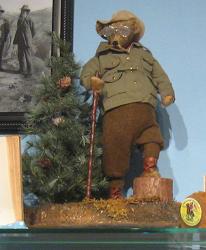AT-ATs, Kachinas and Bears, Oh My!
It's a Small, Weird World After All
Although supposedly America and Germany have resolved their differences over the last 50 years or so, there is one international controversy still raging between the nations: the origin of the teddy bear. The conflict began when Morris Michtom of Brooklyn and Margarete Steiff of Germany both claimed to have invented the ubiquitous toy bear. Steiff may have actually been first, although patriotism demands that I not admit it; but Michtom can certainly take credit for the name, which was inspired by President Teddy Roosevelt.
In November of 1902, almost exactly 105 years ago, President Roosevelt was on a hunting trip in Mississippi and had failed to kill anything at all. Hoping to console him for his wasted trip, the other hunters captured a bear and tied it to a tree for him to shoot. He refused to commit so unsportsmanlike an act, and Mictom, recalling this incident when he created his first toy bear, named it “Teddy’s Bear.”

And since then, the teddy bear has become one of the most popular toys ever to be sold. Children love them, and collectors search for unusual and striking examples of the class-among them, Susan Quinlan of Santa Barbara. Her Doll & Teddy Bear Museum & Library is one of only about ten large-scale museums of this type in the world, and boasts the largest research library on the subject to be found anywhere.
As the museum’s name indicates, it’s not all furry friends. Quinlan’s collection of dolls of all types is incredibly varied, from a replica of Scarlett O’Hara perfect down to the pattern on her dress, to kachina dolls from the Southwest. But it’s the bears that really steal the show. Humans, for some inexplicable reason, love to anthropomorphize animals. Witness the incredible popularity of Disney films with talking animals, the tales of Narnia by C.S. Lewis, and the recent spate of movies about penguins with real human problems any of these examples illustrate the point. Bears dressed in clothes and participating in human activities never fail to tickle a certain kind of person-and, I would argue, almost everyone else as well, though some would rather die than admit it.
Quinlan’s collection, hidden away on Canon Perdido Street, could probably keep anyone entertained, even someone who’s not crazy about dolls. For one thing, she’s organized them very cleverly-one whole room relates a history of California, told through dolls made in the state. One case commemorates the town of Allensworth, the first African American settlement in California. Founded in 1908 by Colonel Allen Allensworth, an escaped slave who earned his rank in the Union Army during the Civil War, the town is now home to the Colonel Allensworth State Historic Park.
Other groups represented in the collection include the Chinese, Japanese, Russian, and Hispanic populations of early California. Simply as cultural artifacts, the dolls are impressive; as toys, they’re amazingly intricate. It’s hard to imagine parents today allowing their children to so much as touch some of these works of art, let alone actually play with them. However, any kids visiting the museum will be enthralled, and adults shouldn’t miss Quinlan’s guided tour her command of the history behind her collection is impressive.
And there’s one other group who shouldn’t miss the experience: nerds. The sci-fi action figure section of the museum is droolworthy for anyone who’s ever owned a Luke Skywalker figurine-the set of Dr. Who Daleks in the original packaging, the Endor Moon diorama complete with trees, Ewoks, and an Imperial soldier on a speeder bike, and the Star Trek figures from every series are enough to send any science fiction fan into a tizzy. I probably shouldn’t admit this in public, but the next time I visit the museum I won’t be coming out for a while-I’m going to ask Quinlan if she’ll let me sit on the floor and play with the AT-AT.
The Susan Quinlan Doll & Teddy Bear Museum & Library is located at 122 W. Canon Perdido Street. Hours are 11 am to 5 pm, Friday through Monday. A phone call is recommended, in case of closure or schedule changes. Call 730-1707, or visit quinlanmuseum.com.



